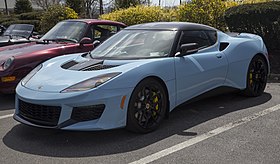| Lotus Evora | |
|---|---|
 Lotus Evora 400 | |
| Overview | |
| Manufacturer | Lotus Cars |
| Production | 2009–2021 6,117 produced |
| Model years | 2010–2021 |
| Assembly | Hethel, Norfolk, United Kingdom |
| Designer | Russell Carr[1] |
| Body and chassis | |
| Class | Sports car (S) |
| Body style | 2-door coupé 2-door 2+2 coupé |
| Layout | Transverse mid-engine, rear-wheel drive |
| Related | Lotus 3-Eleven Infiniti Emerg-e |
| Powertrain | |
| Engine | 3.5 L Toyota 2GR-FE V6[1][2] 3.5 L Toyota 2GR-FE supercharged V6 |
| Transmission | 6-speed Aisin AI manual[1] 6-speed Aisin AI IPS automatic |
| Dimensions | |
| Wheelbase | 2,575 mm (101.4 in)[1] |
| Length | 4,395 mm (173.0 in) |
| Width | 1,848 mm (72.8 in) 1,858 mm (73.1 in) (Evora GT)[3] |
| Height | 1,229 mm (48.4 in) |
| Kerb weight | 1,248 kg (2,751 lb)–1,442 kg (3,179 lb) |
| Chronology | |
| Predecessor | Lotus Europa S |
| Successor | Lotus Emira |
The Lotus Evora is a sports car produced by the British company Lotus.[1] The car, which was developed under the project name Project Eagle, was launched on 22 July 2008 at the British International Motor Show.[4] The Evora S was launched in 2010 with a supercharged 3.5-litre V6. A facelifted and more powerful Evora 400 model was unveiled at the 2015 Geneva Motor Show,[5] followed by another more powerful variant, the Evora GT430, which was unveiled in 2017.[6]
The Lotus Evora is based on the first all-new vehicle platform from Lotus Cars since the introduction of the Lotus Elise in 1995 (the Exige and the 2006 Europa S are both derivatives of the Elise).[7][8] The Evora was planned to be the first of three vehicles to be built on the same platform.[9] The sales target was 2,000 cars per year, with prices between £45,000 and just over £50,000,[1] and sales in America scheduled from the beginning of 2010.[10]
- ^ a b c d e f "Lotus Evora". EVO. Dennis Publishing. 22 July 2008. Retrieved 22 July 2008.
- ^ "London show: Lotus Evora". Autocar. Haymarket Media. 22 July 2008. Archived from the original on 27 July 2008. Retrieved 22 July 2008.
- ^ "2021 Lotus Evora GT". caranddriver.com. 24 November 2020. Retrieved 17 October 2021.
- ^ "2009 Lotus Evora revealed: Project Eagle arrives". Leftlane News. 22 July 2008. Archived from the original on 5 November 2011. Retrieved 22 July 2008.
- ^ "Evora 400". Top Gear. 18 February 2015. Retrieved 18 February 2015.
- ^ "Evora GT430 is the fastest production Lotus ever". road and track. 6 September 2017. Retrieved 6 September 2017.
- ^ Holmes, Jake (March 2008). "2008 Lotus Europa SE – Auto Shows". Car & Driver. Hachette Filipacchi Media U.S. Retrieved 26 August 2009.
- ^ Mitani, Sam (August 2009). "Driving Impression: 2010 Lotus Evora". Road & Track. 60 (12). Newport Beach, California: Hachette Filipacchi Media U.S.: 52–55. Archived from the original on 11 May 2009. Retrieved 26 August 2009.
- ^ "London show: Lotus Evora". Autocar. Haymarket Group. 22 July 2008. Retrieved 26 August 2009.
- ^ Davis, Matt (13 May 2009). "The Baby Ferrari That Ferrari Refuses To Build". Edmunds.com. Retrieved 26 June 2009.[dead link]